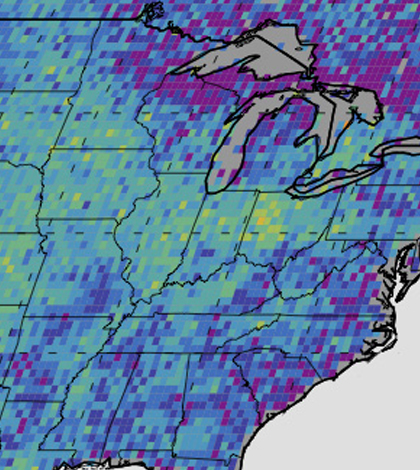Four Corners Methane Hotspot Imaged For First Time

Anomalous U.S. methane emissions (or how much the emissions differ from average background concentrations) for 2003 to 2009, as measured by the European Space Agency's SCIAMACHY instrument. (Credit: NASA/JPL-Caltech/University of Michigan)
Researchers at NASA and the University of Michigan first identified the Four Corners hotspot of methane in 2014. The area, where Arizona, Colorado, New Mexico and Utah intersect, was found to pump out the largest concentrations of methane in the United States. The discovery led to questions as to why such a hotspot could exist or what was causing it.
In an effort to learn more about the Four Corners region and its relationship with methane levels in the air, a team of scientists from NASA has led a recently completed investigation. They used airborne tools as well as sensors on the ground to dissect methane concentrations in the area.
Two NASA spectrometers mounted on research aircraft were able to identify and measure more than 250 sources of methane in the Four Corners. One of the devices used visible and infrared imaging to observe a spectra of reflected sunlight while the other was geared more toward methane’s thermal properties.
The spectrometers made it possible for researchers to image methane features with a spatial resolution of more than 3 square feet. The data were so high-resolution that investigators were able to create a mosaic of methane levels every few feet and spot individual sources.
The sources that scientists identified emitted methane at rates ranging from a few pounds to 11,000 pounds per hour. The fact that such measurements could be taken through airborne means is a positive find, researchers say, and help to prove that tracking methane levels from the air is a reliable approach.
The NASA spectrometers used in the study can identify certain atmospheric gases, including methane, by the way the gases absorb sunlight. The National Oceanic and Atmospheric Administration provided airborne plume measurements that were used to calibrate and validate the NASA data.
Full results of the work are published in the Proceedings of the National Academy of Sciences.
Top image: Anomalous U.S. methane emissions (or how much the emissions differ from average background concentrations) for 2003 to 2009, as measured by the European Space Agency’s SCIAMACHY instrument. (Credit: NASA/JPL-Caltech/University of Michigan)




0 comments